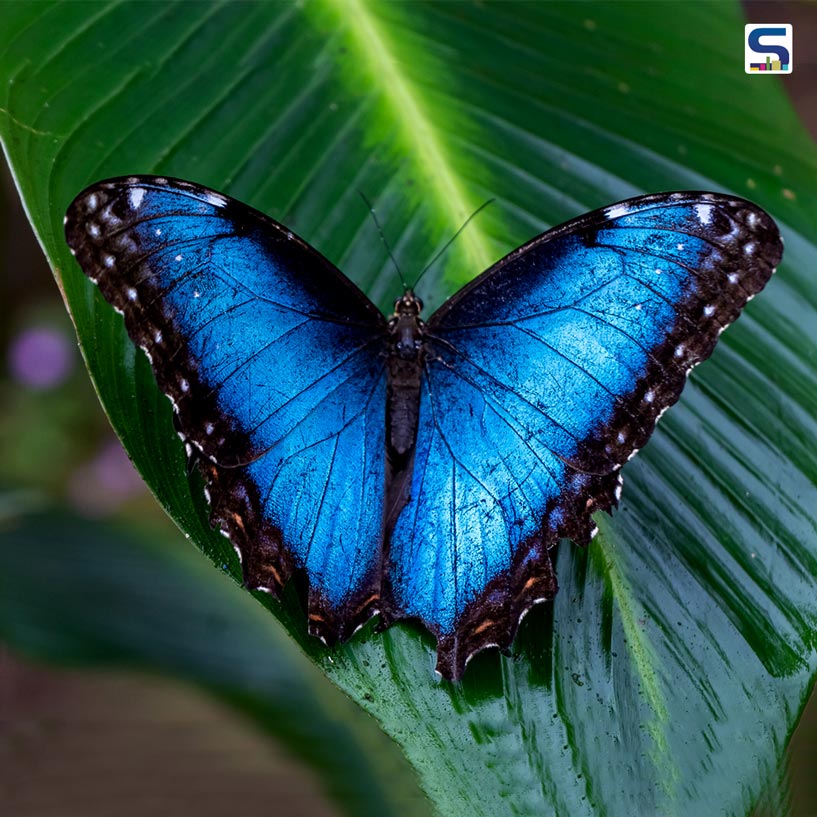
Pigments usually give bright colours to most paints. However, over time these paints usually lose their colour and sheen, and some pigments can be harmful in certain applications. Now, the research group of Debashis Chanda at the NanoScience Technology Center of the University of Central Florida (UCF) has developed a paint dubbed “Plasmonic Paint” without using any pigments. Instead, they got inspired by the same science that gives butterfly wings their vibrant hues. Read more about this innovative paint and how it would help in creating eco-friendly buildings on SURFACES REPORTER (SR):
Paint Gets Its Colour Through Light Reflection
In the past as well, paints have been made using colours from the insects such as cochineal and carmine which give rich blues and blood reds. But this time, the scientists have not used insects as the material rather they took them just as an inspiration to create bright paint hues by using reflection methods.
Like the blue morpho butterflies use light waves to create brilliant blues and speckles, this paint also gets hues that come from particular lightwaves that reflect off the nanostructure of the paint.
So, the blue colour in butterflies is not a blue pigment, but a reflection of blue light. Hence, in short, this paint works through structural colour instead of dyes or chemical pigments.
The science of colours
When either sunlight or artificial light falls on any object, it tends to absorb some of the light and reflect the rest of it. An object that absorbs all the light looks black, while the object that reflects all light looks white, which is the original colour of the light source. But the colours of particular objects show that it has reflected only certain wavelengths of light. This is how the pigments in paints are specifically customised to capture certain wavelengths only. That means the wavelength of light reflected determines the colour you see. So, this is the scientific process of how we see colours in certain things all around us. However, there is another way also to create colour.
Natural colours such as distinct bright hues in the butterfly wings not only come from the light they absorb or the light they reflect on certain wavelengths. Instead, the bright hues are caused by detailed arrangement of reflecting structures on its wings.
Benefits of Structural Paints
Unlike traditional pigment-based paints, this newly developed paint is a structural paint that does not face after being exposed to too much sun. Further, it is lightweight so a little of it will cover the entire surface. Further, it absorbs less heat than conventional paints and keeps the underlying surfaces up to 16 degrees celsius cooler, which means it is great for creating cooler buildings that will at the same time help to reduce the ‘urban heat island effect’, and also facilitate in lowering the cost and energy of ACs in summer.
“Normal color fades because pigment loses its ability to absorb photons,” Chanda says. “Here, we’re not limited by that phenomenon. Once we paint something with structural color, it should stay for centuries."
Materials Used in Creating This Paint
Unlike conventional paints that are made of using pigments or chemicals, this paint is made of using two colourless materials- aluminium and aluminum oxide.
Future Research
According to Chanda, more exploration of the paint’s energy-saving aspects is needed to be done to improve its viability as commercial paint.
Now the paint has been created in a university research lab, but to test its advantages or downsides at a larger scale, this would need to be created in bigger facilities. “The conventional pigment paint is made in big facilities where they can make hundreds of gallons of paint,” he says. “At this moment, unless we go through the scale-up process, it is still expensive to produce at an academic lab.”
If this gets successful, this could be really helpful in cooling down cities. Earlier in 2017, Lexus also launched a similar type of paint- Lexus Structural Blue- using the physics of butterfly wings. However, car owners found that it is difficult to repair even the tiniest scratch with this unusual paint, so one needs to consider this point as well while creating any new kinds of structural paints.

Debashis Chanda, a professor in UCF’s NanoScience Technology Center, drew inspiration from butterfly wings to develop the unusual new paint.
Keep reading SURFACES REPORTER for more such articles and stories.
Join us in SOCIAL MEDIA to stay updated
SR FACEBOOK | SR LINKEDIN | SR INSTAGRAM | SR YOUTUBE
Further, Subscribe to our magazine | Sign Up for the FREE Surfaces Reporter Magazine Newsletter
You may also like to read about:
Asian Paints Introduces Ready-to-Use, Hassle-Free Interior Water-Proofing Solution | SmartCare Hydroloc
Hand-Painted Mural Adorns The Rear Façade of This Sustainable Mixed-Use Building in Salt Lake City, USA | Mya and The Shop SLC
and more...